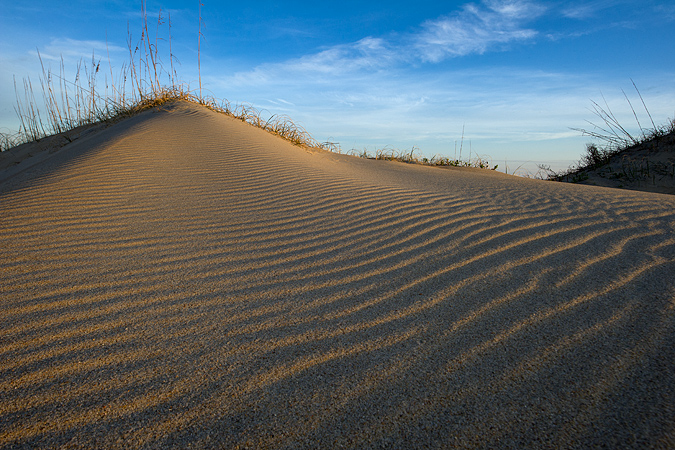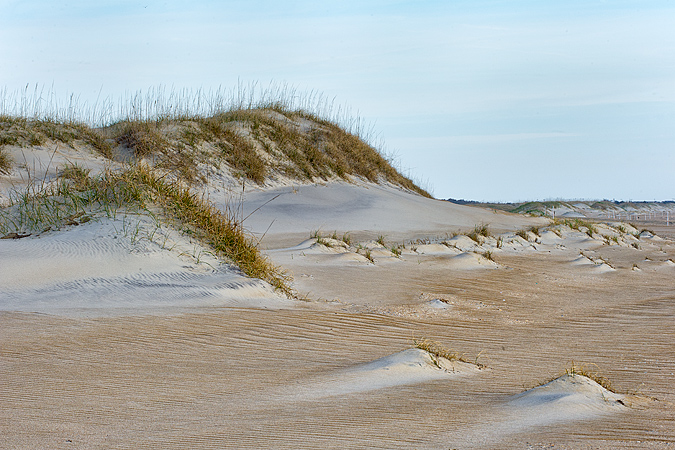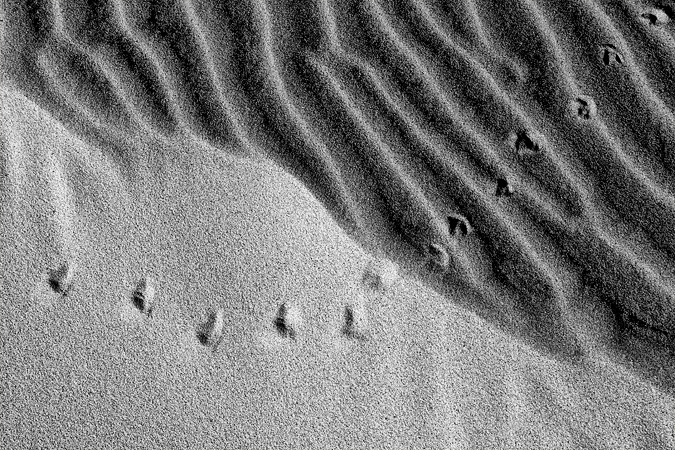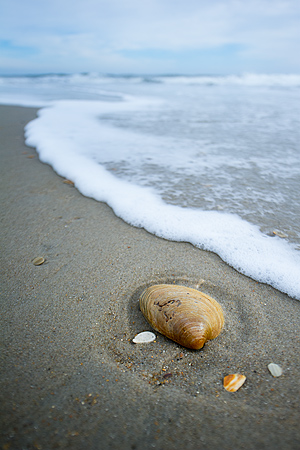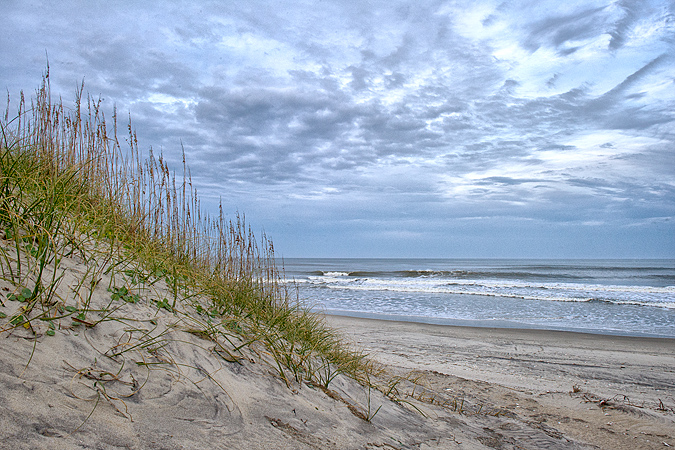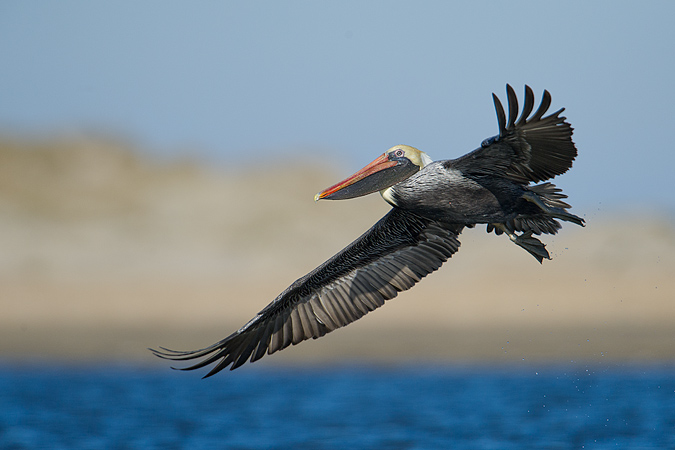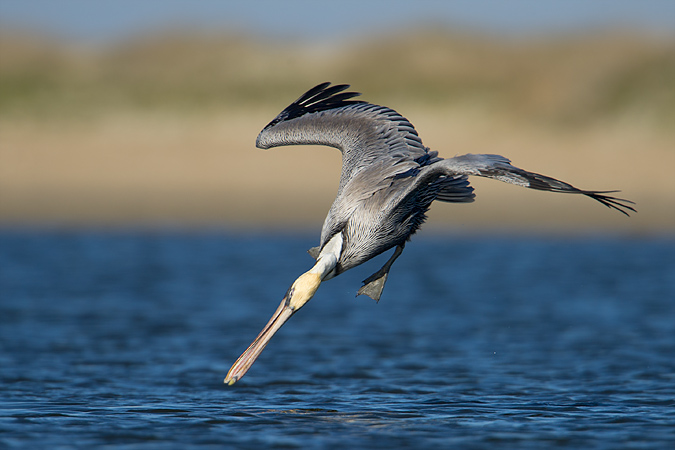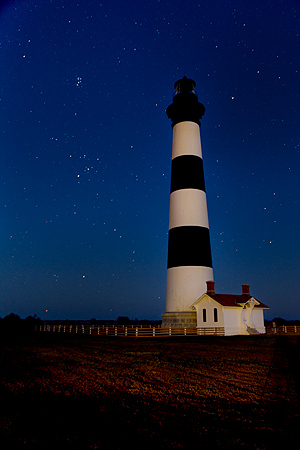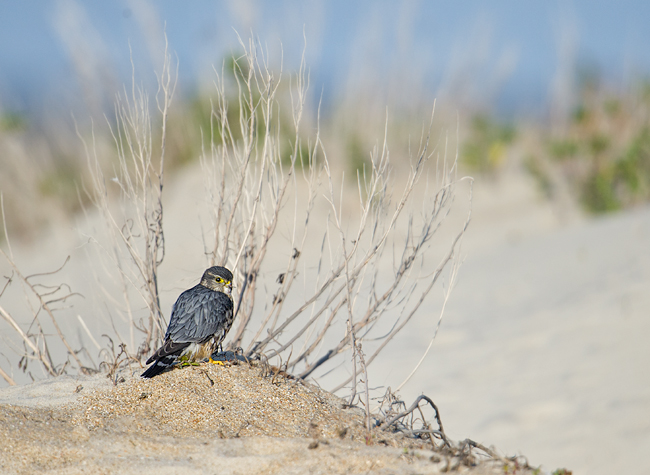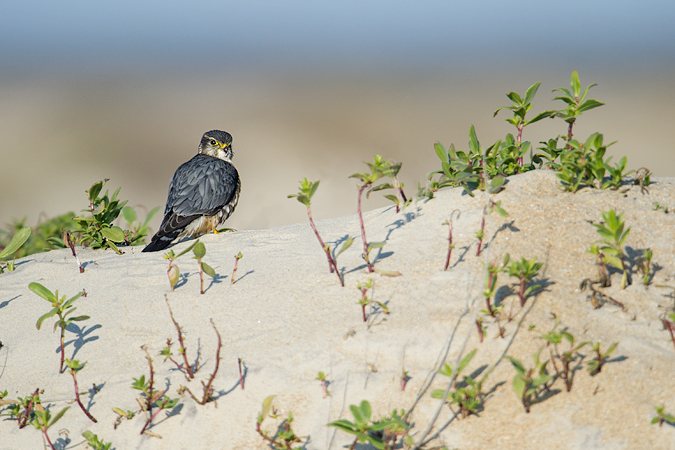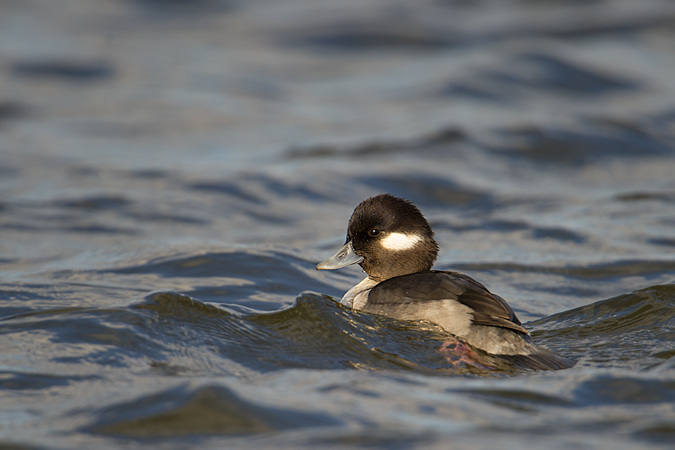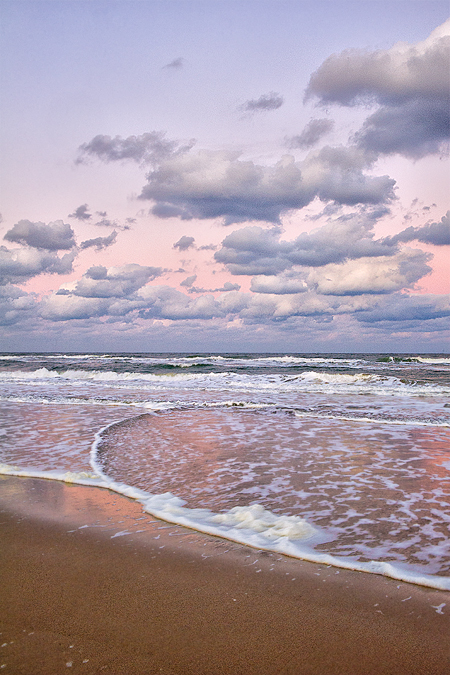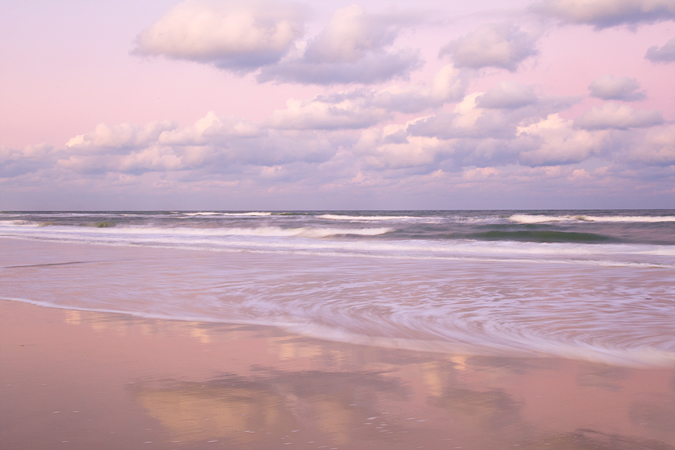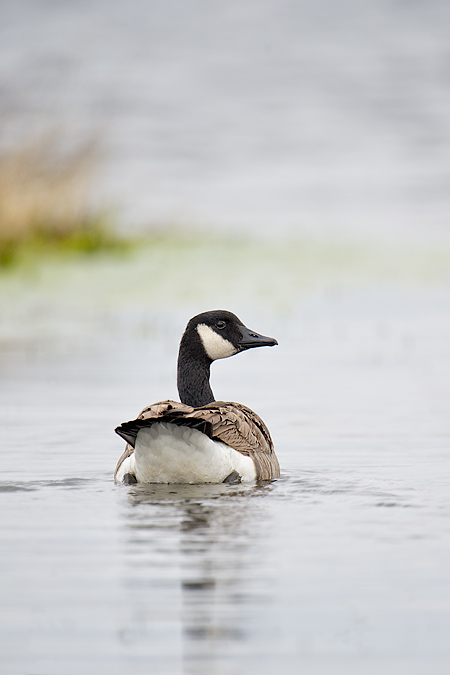When planning my trip, I was unsure about the Outer Banks. On one hand I thought there would be many photographic opportunities. On the other hand, I now live near the ocean. I thought that the Outer Banks might be redundant, offering the same sort of opportunities that I have at my new home. There’s not much point to travelling when you can just take the same type of photos at home. After three days, I had my answer. While still ocean and sandy beaches, the Outer Banks have some marvelous opportunities that are quite different from South Carolina. I never felt like I was duplicating my efforts. For the last bit of time in North Carolina, I decided to focus my efforts on landscapes and left my wildlife lenses inside the car.
One piece of advice everyone tells you about photography is to photograph at sunrise and sunset. That is when the light can be low and soft enough to illuminate the subtle texture of the dunes. But clouds quickly rolled over the sky and the light was no longer giving shadows to the texture. There are plenty of ways to show texture and shape in sand. With the soft mellow light, you need to resort to something else. Sand isn’t all the same color nor the same size. The wind will act differently on the different sizes of sand, creating patterns of color which outline the texture that is in the sand. Clumps of vegetation will push aside the wind as well as adding shape. These elements are working together here to give these dunes shape, depth, and texture.
The sun came back out from the clouds, but by this time the light was a bit harsh. In such cases, concentrating on detail can be fruitful. There were some amazing light and dark ripples in the sand. When I found the footprints of a mouse breaking the yin and yang of these ripples, it was just the kind of thing I had been hoping for.
Always changing, the clouds gathered again. This time, the sun shone through over the point. Storms and changing weather often offer the best light, and it can be good at any time of day.
I have a mental list of somewhere around… 1000 or so photographs that I’m dying to make. These are photographs that I’m always looking for an opportunity for, but haven’t yet gone out of my way to hunt down. One of these photos is the surf pushing up onto a gorgeous shell. I couldn’t find the right the shell on the beach, nor the right situation, but there were some shells. It was enough that I couldn’t resist 🙂
After leaving Cape Hatteras for the final time, it was time to head north. Storm clouds brewed once more and I pulled the car over the side of the road for one last photograph from the Outer Banks. It was going to be many hours before we arrive at our next stop.
Wildlife photography is always unpredictable. It is often full of days when nothing seems to go right, but there are the rare days when nothing can go wrong. Today was one of those special days. It felt like all I had to do was look through the viewfinder and quality images started to fly. The day began with an adorable pair of Whitetail Deer in the sand dunes. The mother was leading her fawn to find the tasty morsels that the dunes offered. They rarely looked at me, but here was one of the few times they did.
After spending a little bit with the deer, I moved on. The day just proceeded to get better. The winds were perfect and I found a great place that was ideal for flight shots. Some of the first images were of the Double-crested Cormorants who were fishing in the area.
While working the cormorants and a few ducks in the area, the big boys flew in. A few at a time, the Brown Pelicans arrived. You really don’t realize how massive these birds are until you see them up close with their wings stretched out.
Their wingspan is just enormous… They use all this surface area to glide over the water, but today there was no need for gliding. The pelicans were actively flying and often just a few feet away. Staying still and low were the key things that made them feel comfortable enough to come in close.
They weren’t here to see me, but it was the fish that brought them in. The pelicans dove repeatedly into the shallow water to catch the fish that were schooling there. It wasn’t long at all before I had taken hundreds of photos of them hard at work.
These opportunities come along once in a blue moon. Naturally I would find a great spot like this only on the last full day at Cape Hatteras. But even if I had the chance for another day or two, getting the conditions that make for the special time I had would be unlikely. Everything has to line up just right – the light, the wind, the birds, the fish, etc. These kind of circumstances remind me of the planets and heavenly bodies – they only line up rarely and you have to seize the opportunity when it arises. On a day so good, I couldn’t stop photographing even after the sun left the sky. A quick stop at nearby Bodie Island delivered one final opportunity.
When I was preparing for my trip to the Outer Banks, one of the reference books I was reading made mention of the weather at Cape Hatteras. Here the weather can change at a moment’s notice. Due to being so close to the Gulf Stream, the Cape can have completely different weather from the mainland just a few miles away. Today began with crystal clear, blue skies. On the walk down to the point, we noticed this Merlin in the area.
I spent quite a bit of time with this little falcon. He was spending his time hiding behind the cover and carefully watching a group of shorebirds nearby. At one point he moved from one dune to another, still watching vigilantly over the shorebirds. I never did see him catch any of the shorebirds, but he was great fun to watch.
After the morning at the point, I decided to head back north. Pea Island NWR is one of those places that seems fantastic for birders, but is rather difficult for photographers, at least when I was there. During the winter, most of the best areas are inaccessible to protect the waterfowl. The one trail you can walk did have some ducks in it. The wind had picked up quite a bit and the skies had turned grey as this Bufflehead swam past.
As I continued northward, the weather really began to change. I was left with one of the most magical sunsets I have experienced. Sometimes the weather and light comes out and you’re looking around frantically for somewhere to pull over and something to put in front of your lens. This was one of those times and everywhere I looked it was private beach access only… Finally somewhere north of Duck (great name for a town), I found a public access point. Working feverishly, the sea and clouds provided the dynamics I was looking for.
One of the things people wonder about with photographers is how much digital editing goes on. Every photographer makes a different decision on this. For me, with wildlife, there is basically none. I just correct the colors and tones to be true to the scene I saw. With my landscape photos though, I do a little more. Here my goal is to be true to the vision or feeling that I wish to share. The light and clouds lasted a little while so I had an opportunity to explore my feelings about the scene. Although not dramatically different, I took a softer approach as I soaked in more of the sunset. In a few more minutes, the light was gone and the colors began to fade. One of the joys of photography is that there is no correct interpretation of a scene, but it gives you the opportunity to share what you are feeling at the time you press the shutter. Like the ocean, that feeling can change at a moment’s notice.
The holidays are rapidly approaching and it’s time to head up to my family in Connecticut. This provides the perfect opportunity for a road trip up through the states on the Atlantic coast with stops at a few destinations. The first stop along the way was the Outer Banks of North Carolina. The morning began with a thrilling confrontation between a Peregrine Falcon who was trying to scare a Great Black-backed Gull off an injured female Northern Shoveler. Perhaps the falcon had originally attacked the duck, but the duck died while the two were going at it. In the end, the gull flew away and the falcon rowed the waterlogged body to shore. It was exciting to watch, but too dark and far off in the water to capture any photos.
Cape Hatteras National Seashore is quite an incredible place. It provides a great stopping place for many wintering ducks. This American Black Duck was one of several ducks who were out foraging in a small pond right next to the seashore. I was once told that every rare bird is a common bird somewhere. The opposite holds true, and now that I’ve moved down to South Carolina I miss some of the birds that were ubiquitous in Michigan. Many think of Canada Geese as pains, but they just don’t show up where I’m at and I have to admit that I find them to be quite handsome birds. So I was happy to find a few feeding at the same pond as the ducks.
The Outer Banks project out quite a way towards the Gulf Stream. This makes it a favored spot for all kinds of sea birds, and there tons of gulls. Birdwatchers come from long distances to spot some of the rarities that can show up. I am happy to spend some time with the more common gulls, like this young Great Black-backed Gull.
Even far from home, you see some of the same wildlife you see on a daily basis. It’s easy to overlook them since you feel that you can always get a photo of them back home. New settings can create new possibilities though, so even the mundane can be magical. For me, the deeply overcast conditions of the day added some softness to this Ring-billed Gull who was resting near the surf.

